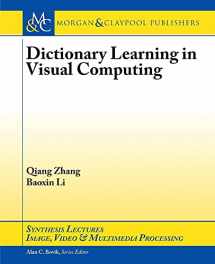
Dictionary Learning in Visual Computing (Synthesis Lectures on Image, Video, and Multimedia Processing)
ISBN-13:
9781627057776
ISBN-10:
1627057773
Author:
Qiang Zhang, Baoxin Li
Publication date:
2015
Publisher:
Morgan & Claypool
Format:
Paperback
133 pages
Category:
AI & Machine Learning
,
Algorithms
,
Programming
,
Computer Science
FREE US shipping
Book details
ISBN-13:
9781627057776
ISBN-10:
1627057773
Author:
Qiang Zhang, Baoxin Li
Publication date:
2015
Publisher:
Morgan & Claypool
Format:
Paperback
133 pages
Category:
AI & Machine Learning
,
Algorithms
,
Programming
,
Computer Science
Summary
Dictionary Learning in Visual Computing (Synthesis Lectures on Image, Video, and Multimedia Processing) (ISBN-13: 9781627057776 and ISBN-10: 1627057773), written by authors
Qiang Zhang, Baoxin Li, was published by Morgan & Claypool in 2015.
With an overall rating of 4.3 stars, it's a notable title among other
AI & Machine Learning
(Algorithms, Programming, Computer Science) books. You can easily purchase or rent Dictionary Learning in Visual Computing (Synthesis Lectures on Image, Video, and Multimedia Processing) (Paperback) from BooksRun,
along with many other new and used
AI & Machine Learning
books
and textbooks.
And, if you're looking to sell your copy, our current buyback offer is $0.3.
Description
The last few years have witnessed fast development on dictionary learning approaches for a set of visual computing tasks, largely due to their utilization in developing new techniques based on sparse representation. Compared with conventional techniques employing manually defined dictionaries, such as Fourier Transform and Wavelet Transform, dictionary learning aims at obtaining a dictionary adaptively from the data so as to support optimal sparse representation of the data. In contrast to conventional clustering algorithms like K-means, where a data point is associated with only one cluster center, in a dictionary-based representation, a data point can be associated with a small set of dictionary atoms. Thus, dictionary learning provides a more flexible representation of data and may have the potential to capture more relevant features from the original feature space of the data. One of the early algorithms for dictionary learning is K-SVD. In recent years, many variations/extensions of K-SVD and other new algorithms have been proposed, with some aiming at adding discriminative capability to the dictionary, and some attempting to model the relationship of multiple dictionaries. One prominent application of dictionary learning is in the general field of visual computing, where long-standing challenges have seen promising new solutions based on sparse representation with learned dictionaries. With a timely review of recent advances of dictionary learning in visual computing, covering the most recent literature with an emphasis on papers after 2008, this book provides a systematic presentation of the general methodologies, specific algorithms, and examples of applications for those who wish to have a quick start on this subject.


We would LOVE it if you could help us and other readers by reviewing the book
Book review

Congratulations! We have received your book review.
{user}
{createdAt}
by {truncated_author}


